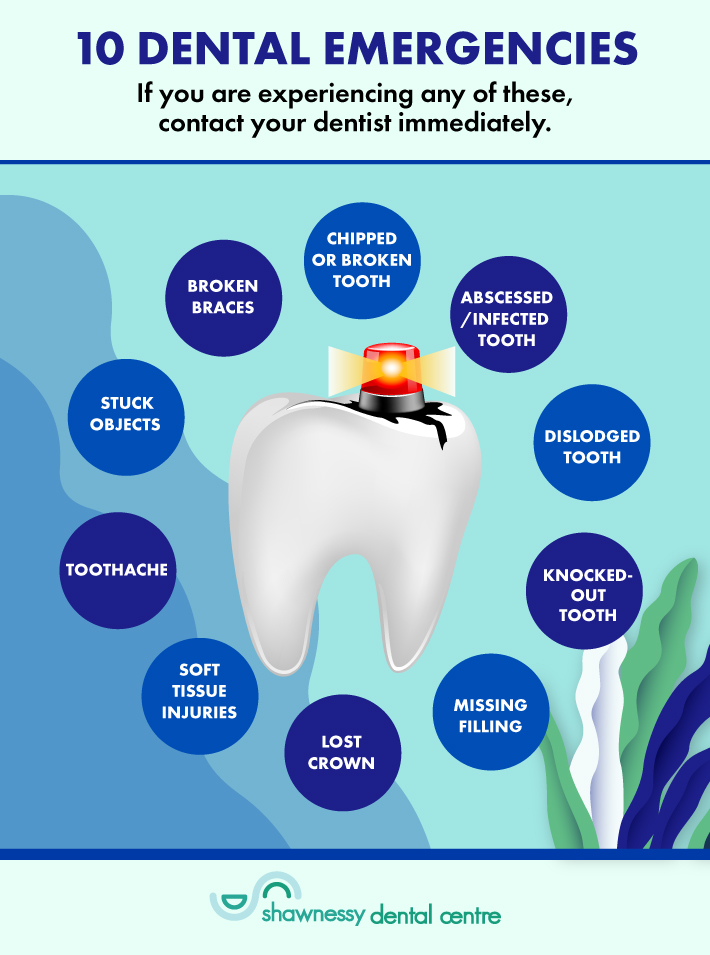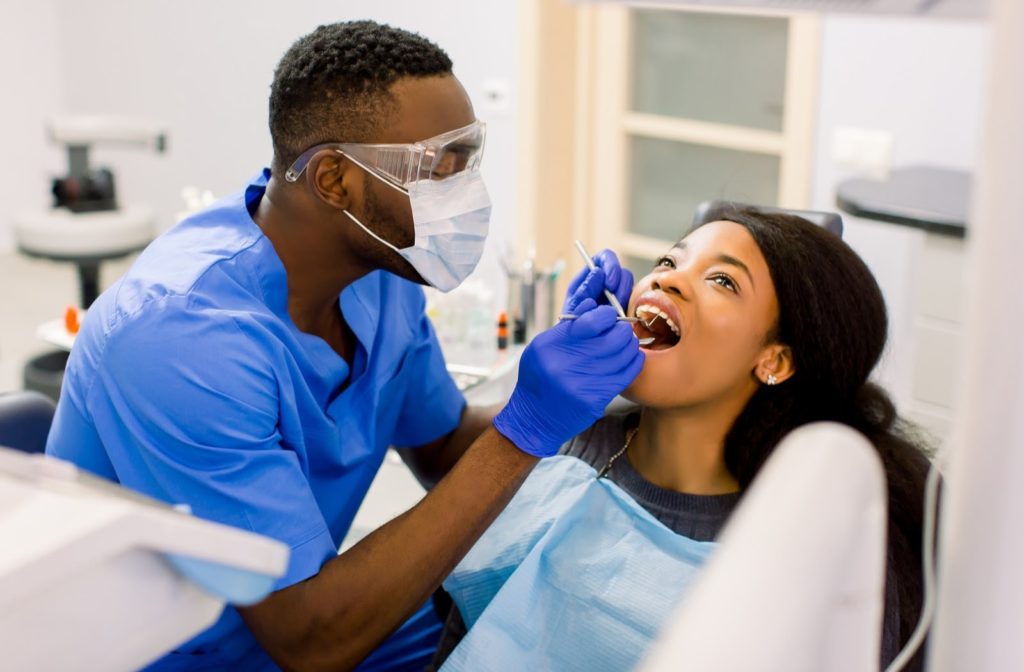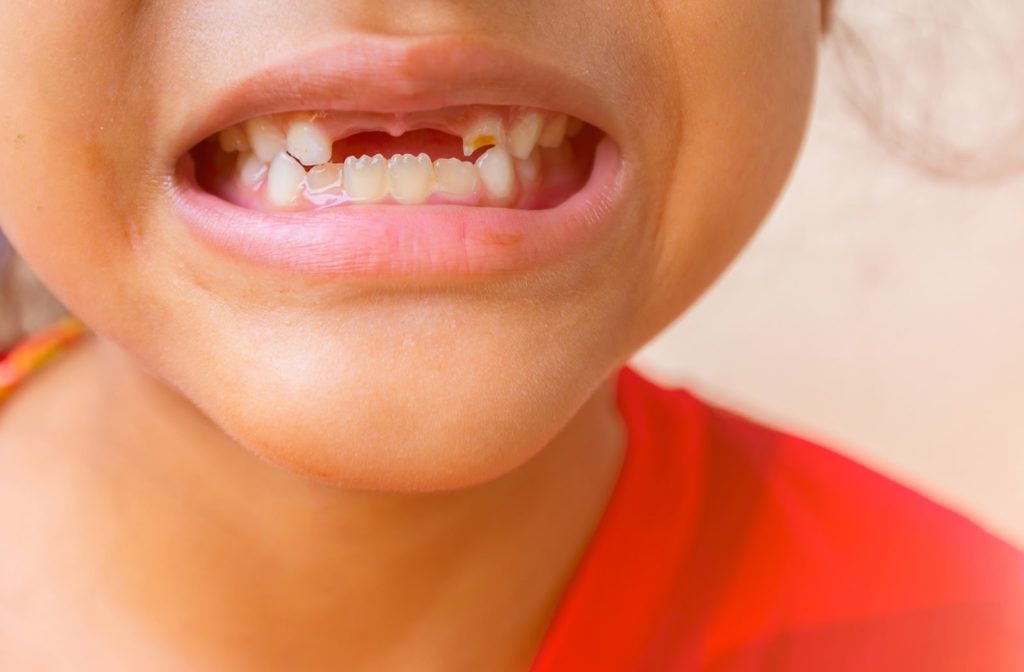We don’t usually plan to see our dentist outside of a scheduled exam or cleaning. Unfortunately, accidents happen and they can affect your dental health.
Do you know what to do if you experience a dental emergency? Learn about 10 common dental emergencies, their causes, and what to do if they happen to you.
10 Common Dental Emergencies
Our mouths and teeth are fragile, and there are many ways to damage them. Biting your cheek won’t make this list, but some common emergencies include:
- Chipped or broken tooth
- Abscessed tooth
- Dislodged tooth
- Knocked-out tooth
- Missing filling
- Lost crown
- Soft tissue injuries
- Toothache
- Stuck objects
- Broken braces
Each bullet-point warrants a trip to the dentist’s office, but some require more urgent medical attention. How do you know when you need to see your dentist, and how do you protect your teeth until you’re seen?

Chipped or Broken Tooth
Chipped or broken teeth can occur suddenly or develop over time. Damage to the teeth can be minor (chips, cracks, or breaks in the enamel) to severe (damage to the inner layers). Common causes are grinding your teeth, taking a fall, or biting down incorrectly.
If you chip a tooth, apply a cold compress to the outside of your mouth near the affected area. Apply gauze for 10 minutes if there is any bleeding and see your dentist as soon as possible.
Abscessed Tooth
Abscessed teeth are caused when a pocket of pus develops from a bacterial infection within the tooth. Common causes of these infections are tobacco, injury, and systemic disorders. Symptoms of a tooth abscess include:
- Fever
- Tooth sensitivity
- Pressure sensitivity
- Throbbing toothache
- Temperature sensitivity
- Difficulty breathing or swallowing
Until you can see your dentist, reduce pain and swelling with a cold compress on your cheek. Wrap a thin piece of cloth around the ice and only apply pressure for 10 to 20 minutes at a time. Over-the-counter medication is useful for pain relief.
Dislodged Tooth
A dislodged or extruded tooth is a displacement of the tooth from its socket, usually caused by trauma. It’s important to see your dentist right away if you experience a dislodged tooth. Cold compresses, Tylenol, and Advil are effective pain relievers until you’re seen.
Knocked-Out Tooth
If your tooth is knocked out, the solution is straightforward. The affected tooth can be reimplanted if the following steps are correctly performed:
- Locate the missing tooth, and retrieve it
- Don’t touch its roots and handle from the top
- Inspect the crown and root for fractures and missing pieces
- Don’t scrape the tooth or remove any materials
- If unclean, rinse the tooth for no more than 10 seconds in a bowl of lukewarm water
- Try to insert the tooth back into the socket, bite down gently on a moist paper towel if the tooth isn’t fully in place
- Place the tooth between your gum and cheek, or in cold milk if it does not fit inside the socket
- Get to your dentist or an emergency room immediately
Fixing a knocked-out tooth is time-sensitive. If not implanted within 2 hours, there is a low likelihood of success.
Missing Fillings
Dental fillings can fall out for a variety of reasons, including:
- Teeth grinding
- Crunchy foods
- New tooth decay
- Trauma
- Chewing too hard
If a filling falls out, place sugarless gum or over-the-counter dental cement into the cavity until your dentist can see you. Take Advil or another over-the-counter solution for any pain or discomfort.
Lost Crown
Lost crowns are commonly caused by tooth decay and adhesive material loosening with time. Call your dentist as soon as possible if you lose a crown. If it cannot be reapplied, a new one will be made.
Soft Tissue Injuries
Biting your tongue or cheek are common occurrences, but trauma can cause serious damage to the tongue. Sports accidents, unconscious chewing, seizures, or sleep spasms are all common causes. If you injure your tongue, follow these steps:
- Rinse your mouth with water and inspect the injury
- Look for pieces of debris (wear gloves if placing hands inside your mouth)
- Use wrapped ice to reduce swelling
- Apply pressure with a clean cloth if there is bleeding
- Seek medical care if bleeding continues through pressure
While soft tissue injuries can often be treated at home, we recommend you see a medical professional if needed.

Toothache
Almost everyone has experienced a toothache at some point. Cavities are the primary source of toothaches, but other causes include:
- Food and debris caught between teeth
- Inflammation or infection
- Tooth fractures
- Sinus infections
A toothache might not feel like an emergency, but if you feel any persistent pain, fever, or signs of infection you should contact your dentist.
Stuck Objects
Everyone has had a piece of spinach stuck between their teeth at least once, and dental floss usually provides a quick fix. If you get something more serious caught in your teeth, carefully attempt to remove the object and discard it. Do not use sharp or pointed objects to avoid causing damage to your gums or teeth. Call your dentist if you cannot remove the object on your own.
Broken Braces
Wires from your braces can break or stick out from the bracket or band. If this happens, you’ll be visiting your dentist soon. Until then, use the blunt end of a pencil to push the wire into a more comfortable position. Cover any exposed wire with cotton balls or gauze if it cannot be moved. Never attempt to cut or remove a loose wire.
Visit your Dentist
These emergencies all have one common solution: your dentist! Call or book an appointment if you’re experiencing an emergency, pain, discomfort, or need a regular exam.


